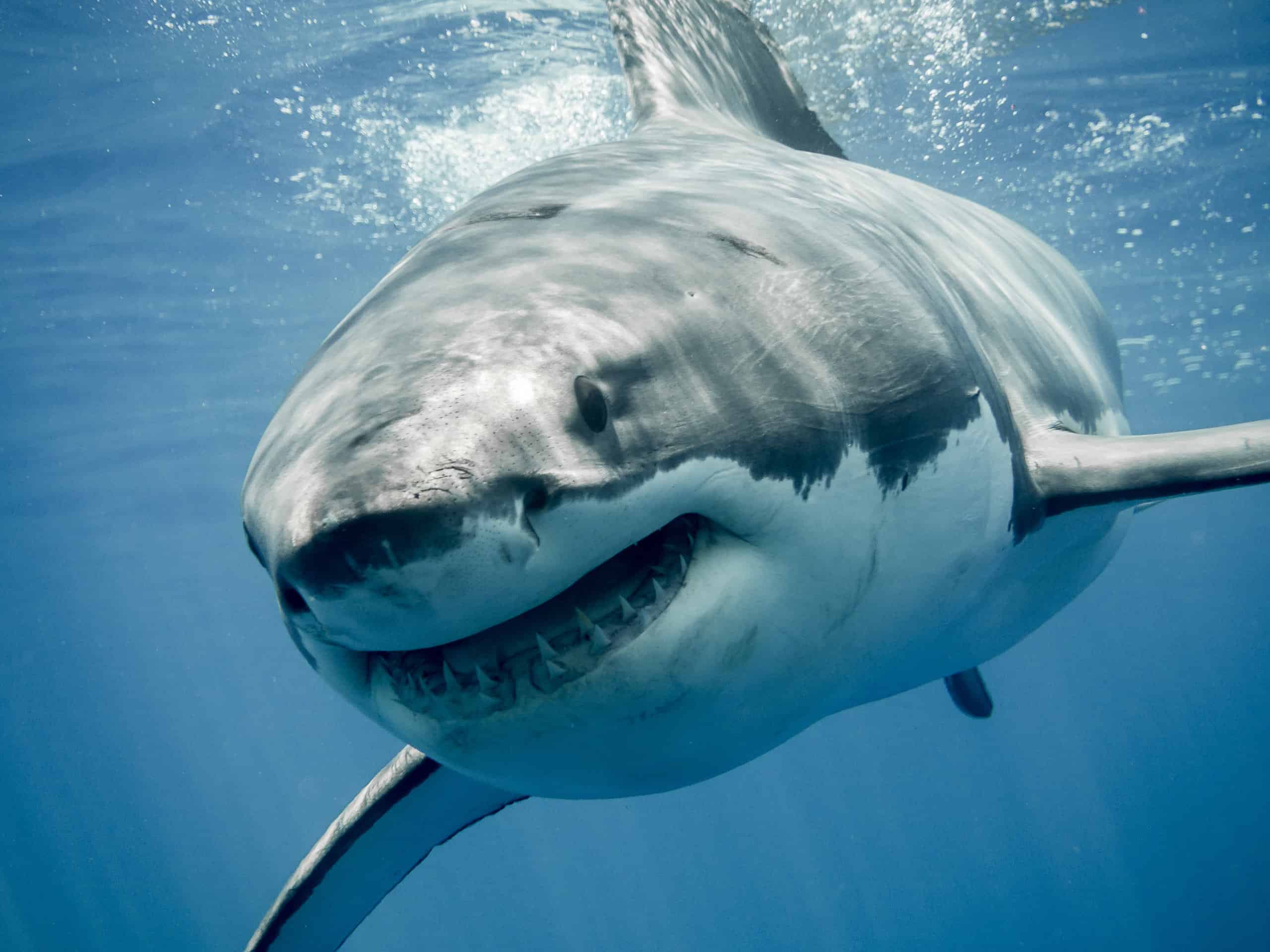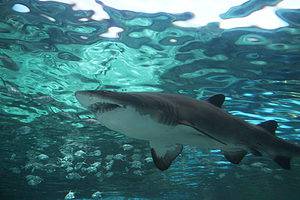Located in the Pacific Ocean, Hawaii is famous for its white sandy beaches and beautiful blue waters. The warm coastal waters surrounding the Hawaiian Islands provide a tropical paradise not only for humans, but for many types of sharks as well.
In fact, there are around 40 different species of sharks in Hawaii! In addition, some of the largest sharks in the world can be found swimming alongside Hawaii’s picturesque coasts and beaches.
Take a look at the 10 biggest sharks in Hawaii!
1. Whale Shark
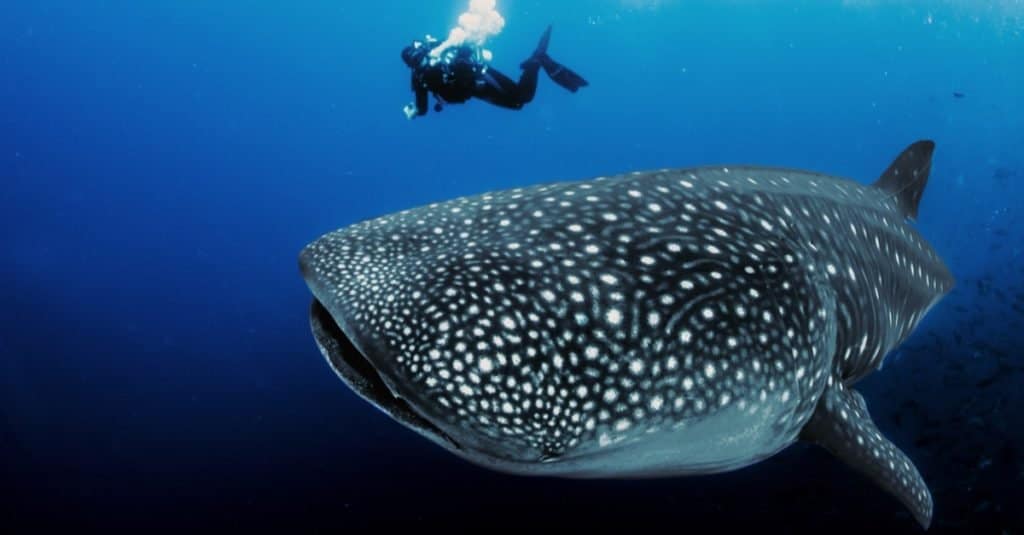
Each whale shark has its own unique pattern of spots, much like human fingerprints. A whale shark’s mouth is about 5 feet wide (1.5 m). They have rows of over 300 teeth, but as filter feeders, they do not use these teeth to eat.
©Lindsey Lu/Shutterstock.com
The biggest shark found in Hawaiian waters is the Whale Shark. Like its name, the body of a whale shark looks more like a whale than an actual shark. Whale sharks are the largest fish on earth and can grow up to 60 feet in length. Their mouths alone are nearly 4 feet wide and are filled with 3,000 tiny teeth.
Unlike many of Hawaii’s other sharks, however, these sharks do not use their teeth for hunting or eating. Whale sharks are filter feeders, and eat several types of nekton and plankton, as well as small fish, squid, and crustaceans. They are known for their gentle and non-aggressive nature and can often be seen feeding along the surface of the water.
| Size | Color | Species |
|---|---|---|
| Weight: 41887.83 lbs Length: 32.8084 feet | Grayish blue with white spots | Whale Shark |
2. Great White Shark
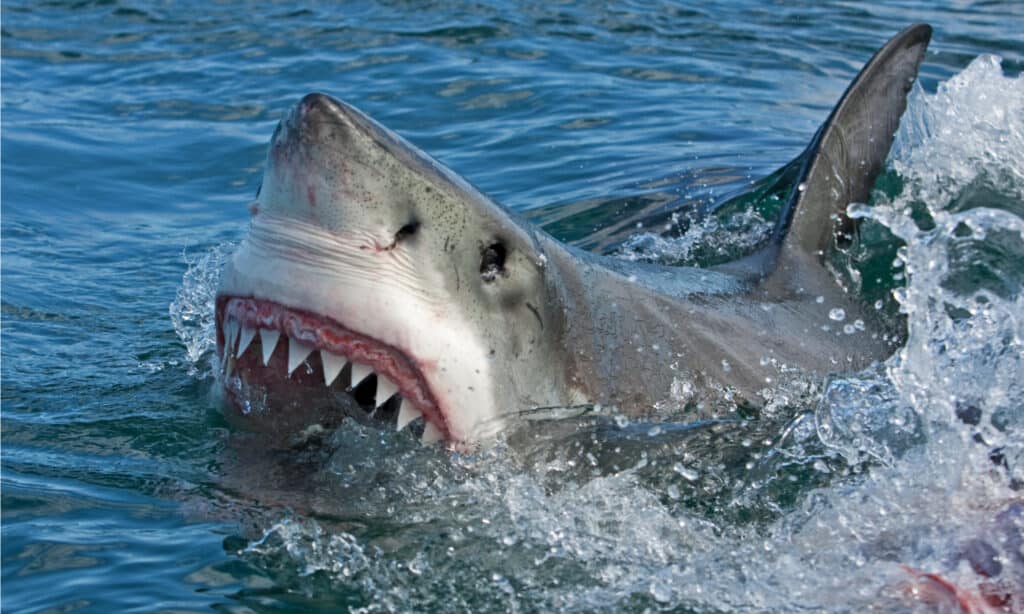
Great White Sharks are one of the most famous and iconic shark species, thanks to films like
Jaws.©Martin Prochazkacz/Shutterstock.com
Hawaii is also home to Great White Sharks, although they are not commonly encountered by humans. These sharks travel through the area mainly during colder months from January to April. Great white sharks have thick, torpedo-shaped bodies with gray backs, white bellies, and a symmetrical tail. These iconic creatures are some of the largest sharks in the world, growing more than 20 feet in length. In fact, great white sharks never truly stop growing—they simply continue to get bigger as they get older.
“Deep Blue,” the largest great white shark ever recorded, has been encountered in the ocean waters near Hawaii. Recent estimates suggest that this infamous female shark is over 20 feet long and weighs around 4,500 pounds! Experts believe that Deep Blue is probably around 50 years old, so she may still have many more years of life ahead of her.
| Size | Color | Species |
|---|---|---|
| Weight: 5,000 lbs Length: 20 feet | Snow White to Grey | Great White Shark |
3. Megamouth Shark

Megamouth shark, Megachasma pelagios, at Toba Aquarium, Japan. The Megamouth Shark, gets its name from its tub-like mouth.
In 1976 an unidentified shark was found tangled in the anchor of a United States navy ship in Hawaii. The first of its kind, this new species was named the “Megamouth Shark” due to its extremely wide mouth. Decades later we still do not know a lot about these strange sharks because they are so rarely seen. Most research comes from dead sharks that have washed up on beaches.
Megamouth sharks can grow up to 18 feet in length, with blackish-brown backs and creamy-colored bellies. Their heads are unusually wide for a shark, with short, rounded snouts. The sharks’ namesake mouth is massive, stretching all the way across the width of the snout.
| Size | Color | Species |
|---|---|---|
| Weight: 2,600 lbs Length: 16 feet | Brownish-Black | Megamouth Shark |
4. Bigeye Thresher Shark
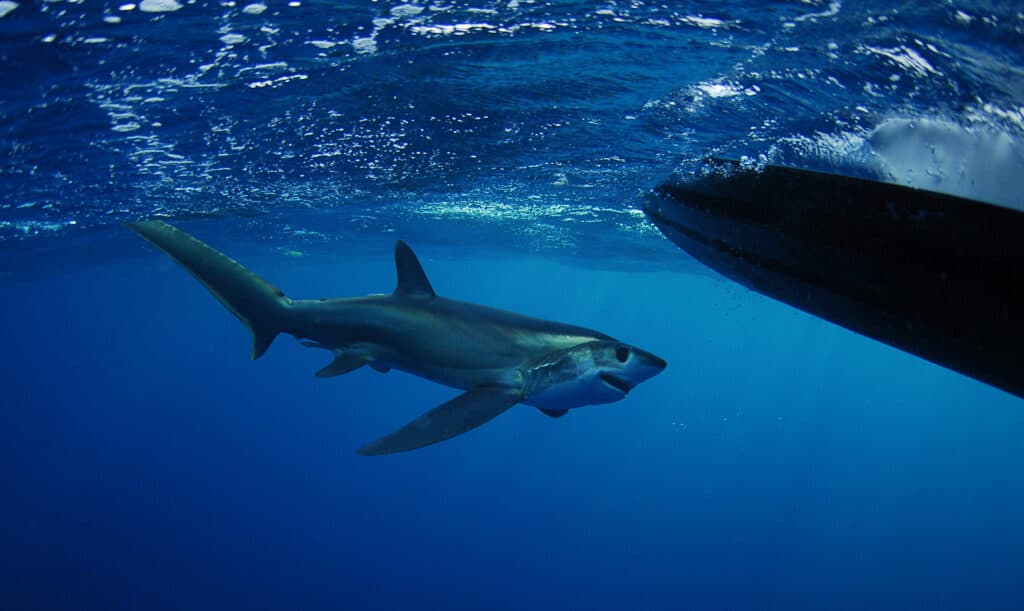
Bigeye Thresher shark swimming in the Gulfstream in the Atlantic Ocean. This thresher shark has extremely large eyes, adapted to hunt in low-light conditions.
©FtLaud/Shutterstock.com
Like its name, the Bigeye Thresher Shark has enormous eyes that help it to see in low lighting. The shark’s most iconic feature, however, is its extremely long tail. The top portion of the shark’s tail is almost as long as the rest of its body! Thresher sharks use these long, whip-like tails to stun and kill fish before eating them.
Bigeye thresher sharks are purplish- or violet-gray with white or light gray bellies. The top of their heads looks almost like a helmet with a V-shaped groove. Bigeye thresher sharks occasionally swim close to shore, but more commonly live in open ocean waters
| Size | Color | Species |
|---|---|---|
| Weight: 350 lbs Length: 16 feet | Purple-Gray to Brownish Gray | Bigeye Thresher Shark |
5. Tiger Shark

Female
tiger
sharks are bigger than male tiger sharks.
©le bouil baptiste/Shutterstock.com
One of the more threatening sharks in Hawaii is the Tiger Shark. These sharks can grow up to 16 feet in length and have spots or stripes along the sides of their bodies that fade as they get older. Tiger sharks also have very distinctive teeth that are 1-2 inches long and curved with extremely sharp, serrated edges.
Tiger sharks will eat just about anything. In fact, they are often called the “garbage cans of the sea”. These sharks have been known to consume anything from marine animals to old tires and license plates. They are also more aggressive than most of the sharks found in Hawaii’s waters. Tiger sharks are the most dangerous sharks in Hawaii, but they are not commonly seen.
| Size | Color | Species |
|---|---|---|
| Weight: 2,000 lbs Length: 18 feet | Gray with Dark Gay Vertical Bars or Spots | Tiger Shark |
6. Scalloped Hammerhead Shark

Scalloped Hammerhead Sharks use their uniquely-shaped heads to pin prey like sting rays to the ocean floor.
©Ian Scott/Shutterstock.com
There are two different types of Hammerhead Sharks that are common in Hawaii. These sharks are some of the most recognizable marine animals because of their unique, flattened heads, shaped much like a hammer. The first species, the scalloped hammerhead shark, has an indentation in the center of its iconic hammer-like head, giving the edge a scallop-like pattern.
Scalloped hammerhead sharks can grow up to 14 feet in length and are one of the most commonly encountered sharks in Hawaii. They generally live offshore, but often come into bay areas for tanning and to give birth. Baby sharks, or “pups”, live together in these shallow nursery areas until they are large enough to join other adult sharks.
| Size | Color | Species |
|---|---|---|
| Weight: 80 lbs Length: 14 feet | Gray or Gray-Brown | Scalloped Hammerhead Shark |
7. Smooth Hammerhead Shark
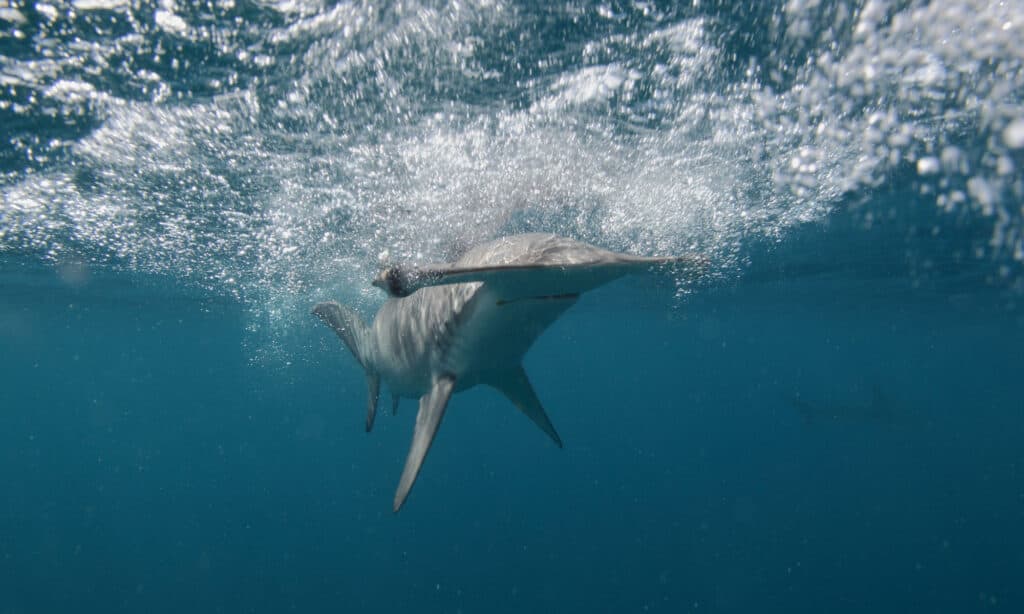
Smooth Hammerhead Sharks eat rays, bony fish, cephalopods, other small sharks, and crustaceans.
©Alessandro De Maddalena/Shutterstock.com
The second species of hammerhead shark found in Hawaii is the Smooth Hammerhead Shark. Like the scalloped hammerhead, this shark has a large, flattened head that resembles the top of a hammer. However, smooth hammerhead sharks have smooth snouts without any marks or indentations in the middle. These sharks often prefer living in shallow water, although they are not as commonly seen as scalloped hammerhead sharks.
| Size | Color | Species |
|---|---|---|
| Weight: 880 lbs Length: 16.5 feet | Gray and White | Smooth Hammerhead Shark |
8. Shortfin Mako Shark
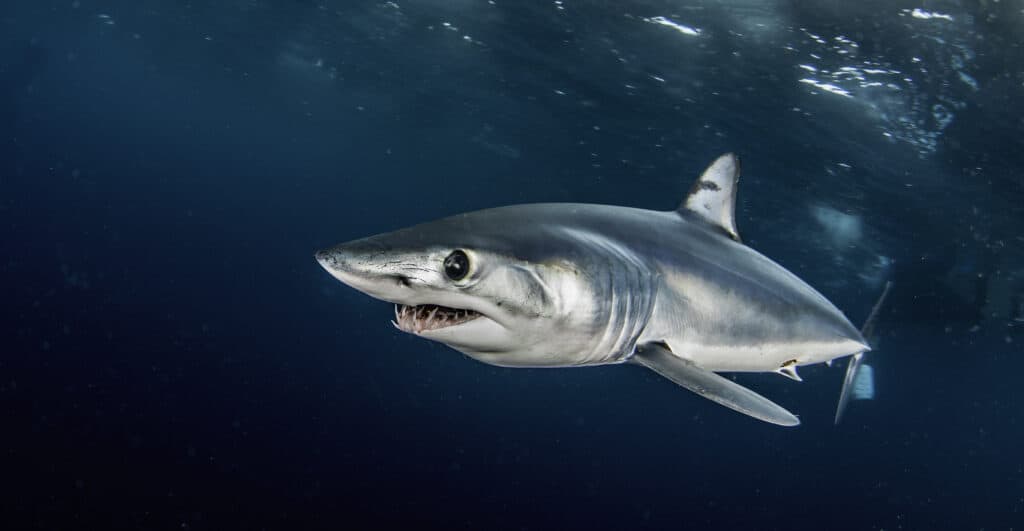
Shortfin mako sharks are aggressive predators and should be avoided if possible.
©wildestanimal/Shutterstock.com
Growing up to 12 feet in length, the Shortfin Mako Shark has an iconic appearance with its blueish gray back, lighter metallic blue sides, and white belly. This shark has a pointy snout and long, pointy teeth that are visible even when it closes its mouth. Although it looks very similar to the Longfin Mako Shark, the Shortfin mako shark, of course, has short pectoral fins.
Shortfin mako sharks are aggressive hunters and eat many different types of fish, including other sharks. They are fast swimmers with excellent agility, and have been recorded swimming at speeds as high as 45 mph.
| Size | Color | Species |
|---|---|---|
| Weight: 1200 lbs Length: 12 feet | Gray-Silver | Shortfin Mako Shark |
9. Longfin Mako Shark
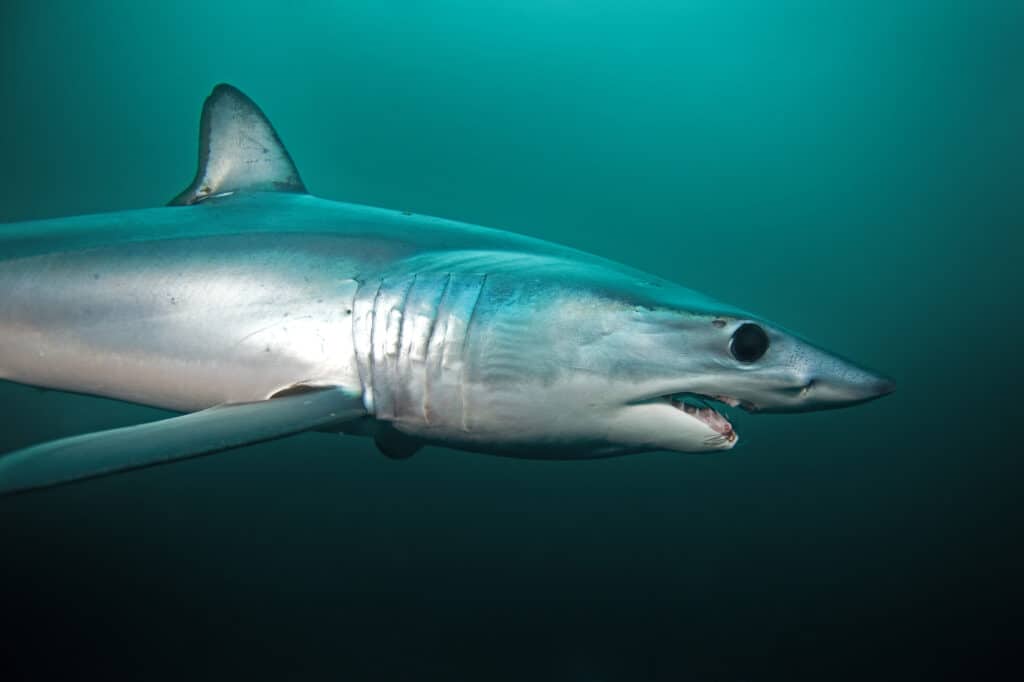
The Longfin Mako shark is a very large species of shark that can grow to around 14 feet.
©Martin Prochazkacz/Shutterstock.com
It can be difficult to tell the difference between the two different species of mako sharks in Hawaii. The most distinguishing feature, however, is the length of their pectoral fins. Unlike the shortfin mako shark, the Longfin Mako Shark has unusually long pectoral fins. Longfin mako sharks are also slightly larger than their short-finned relatives and can grow up to 14feet long. These sharks spend most of their time in the open ocean and are not commonly encountered in Hawaii’s coastal waters.
| Size | Color | Species |
|---|---|---|
| Weight: 1,100 lbs Length: 14 feet | Shiny Gray or Silver | Longfin Mako Shark |
10. Bluntnose Six-Gill Shark
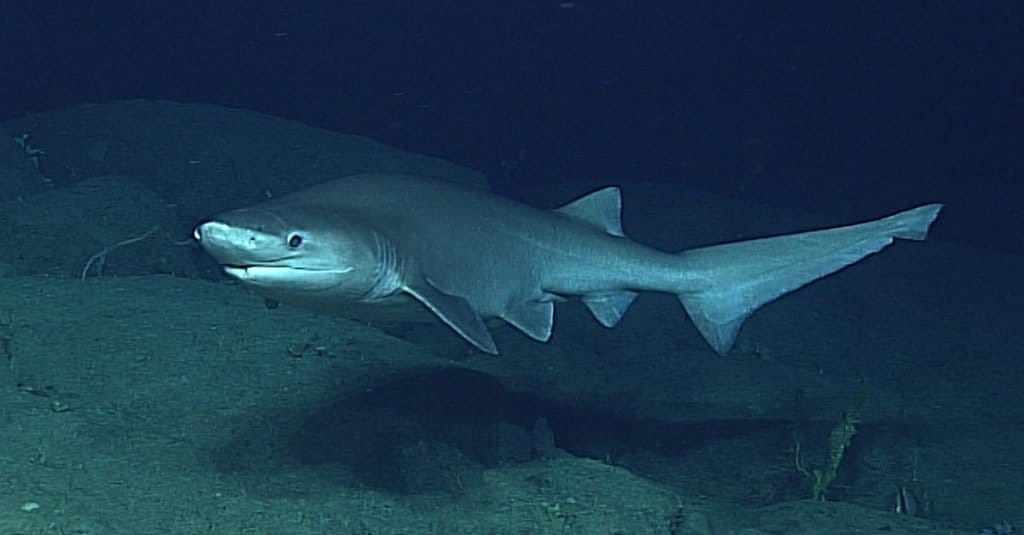
Sixgill shark (Hexanchus griseus) seen while exploring Santa Rosa Reef, south of Guam, during the first dive of the Deepwater Exploration of the Marianas expedition.
©NOAA Ocean Explorer from USA / CC BY-SA 2.0 – Original / License
The Bluntnose Six-Gill Shark has a rounded or blunt snout and a large, thickset body that can grow up to 16 feet in length. Its large body is brown, brownish gray, or olive-green, with paler sides and a creamy white belly. Unlike many other sharks, the bluntnose six-gill shark has only one, small dorsal fin near its tail. There are six distinct gill flaps on either side of its body, and its pectoral fins have a thin line of white along the edges.
Bluntnose six-gill sharks often live in coastal waters, most commonly deep near the ocean floor. They are strong but slow swimmers that hunt mostly at night. These sharks do not like physical contact and will swim away from humans unless provoked. In fact, in the last 500 years only one bluntnose shark has ever attacked a human.
| Size | Color | Species |
|---|---|---|
| Weight: 880 lbs Length: 13 feet | Grayish-Blue | Bluntnose Six-Gill Shark |
Thank you for reading! Have some feedback for us? Contact the AZ Animals editorial team.

